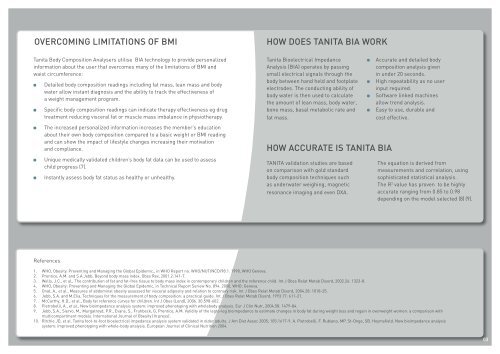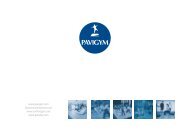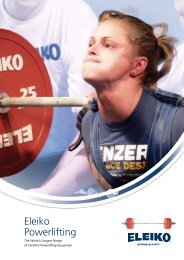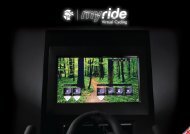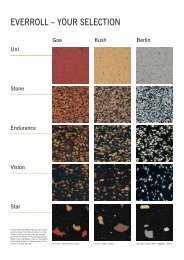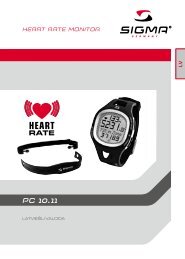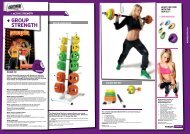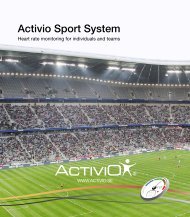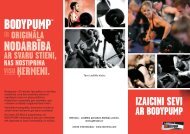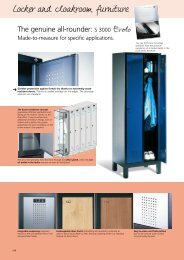PROFESSIONAL CATALOGUE - Gfitness
PROFESSIONAL CATALOGUE - Gfitness
PROFESSIONAL CATALOGUE - Gfitness
You also want an ePaper? Increase the reach of your titles
YUMPU automatically turns print PDFs into web optimized ePapers that Google loves.
OVERCOMING LIMITATIONS OF BMI<br />
Tanita Body Composition Analysers utilise BIA technology to provide personalized<br />
information about the user that overcomes many of the limitations of BMI and<br />
waist circumference:<br />
Detailed body composition readings including fat mass, lean mass and body<br />
water allow instant diagnosis and the ability to track the effectiveness of<br />
a weight management program.<br />
Specific body composition readings can indicate therapy effectiveness eg drug<br />
treatment reducing visceral fat or muscle mass imbalance in physiotherapy.<br />
The increased personalized information increases the member’s education<br />
about their own body composition compared to a basic weight or BMI reading<br />
and can show the impact of lifestyle changes increasing their motivation<br />
and compliance.<br />
Unique medically validated children’s body fat data can be used to assess<br />
child progress (7).<br />
Instantly assess body fat status as healthy or unhealthy.<br />
References<br />
HOW DOES TANITA BIA WORK<br />
Tanita Bioelectrical Impedance<br />
Analysis (BIA) operates by passing<br />
small electrical signals through the<br />
body between hand held and footplate<br />
electrodes. The conducting ability of<br />
body water is then used to calculate<br />
the amount of lean mass, body water,<br />
bone mass, basal metabolic rate and<br />
fat mass.<br />
HOW ACCURATE IS TANITA BIA<br />
TANITA validation studies are based<br />
on comparison with gold standard<br />
body composition techniques such<br />
as underwater weighing, magnetic<br />
resonance imaging and even DXA.<br />
Accurate and detailed body<br />
composition analysis given<br />
in under 20 seconds.<br />
High repeatability as no user<br />
input required.<br />
Software linked machines<br />
allow trend analysis.<br />
Easy to use, durable and<br />
cost effective.<br />
The equation is derived from<br />
measurements and correlation, using<br />
sophisticated statistical analysis.<br />
The R 2 value has proven to be highly<br />
accurate ranging from 0.85 to 0.98<br />
depending on the model selected (8) (9).<br />
1. WHO, Obesity. Preventing and Managing the Global Epidemic., in WHO Report no. WHO/NUT/NCD/98.1. 1998, WHO Geneva.<br />
2. Prentice, A.M. and S.A.Jebb, Beyond body mass index. Obes Rev, 2001.2:141-7.<br />
3. Wells, J.C., et al., The contribution of fat and fat-free tissue to body mass index in contemporary children and the reference child. Int J Obes Relat Metab Disord, 2002.26: 1323-8.<br />
4. WHO, Obesity: Preventing and Managing the Global Epidemic, in Technical Report Seriew No. 894. 2000, WHO: Geneva.<br />
5. Onat, A., et al., Measures of abdominal obesity assessed for visceral adiposity and relation to coronary risk. Int J Obes Relat Metab Disord, 2004.28: 1018-25.<br />
6. Jebb, S.A. and M.Elia, Techniques for the measurement of body composition: a practical guide. Int J Obes Relat Metab Disord, 1993.17: 611-21.<br />
7. McCarthy, H.D., et al., Body fat reference curves for children. Int J Obes (Lond), 2006. 30:598-602.<br />
8. Pietrobelli, A., et al., New bioimpedance analysis system: improved phenotyping with wholebody analysis. Eur J Clin Nutr, 2004.58: 1479-84.<br />
9. Jebb, S.A., Siervo, M., Murgatroyd, P.R., Evans, S., Fruhbeck, G, Prentice, A.M. Validity of the legto-leg bioimpedance to estimate changes in body fat during weight loss and regain in overweight women: a comparison with<br />
multicompartment models. International Journal of Obesity (In press).<br />
10. Ritchie JD, et al. Tanita foot-to-foot bioelectrical impedance analysis system validated in older adults. J Am Diet Assoc 2005; 105:1617-9. A. Pietrobelli, F. Rubiano, MP. St-Onge, SB. Heymsfield. New bioimpedance analysis<br />
system: improved phenotyping with whole-body analysis. European Journal of Clinical Nutrition 2004.<br />
03


